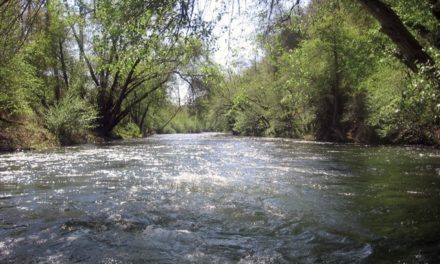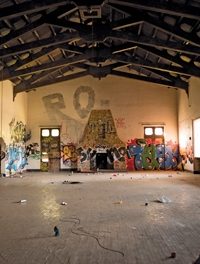The Navy’s cleanup of an old airfield, known as Site 32, is nearing completion, paving the way for a new park and wetlands.
Considering the revelations of faked testing and fraudulent reporting that dogged the environmental cleanup of Hunters Point Naval Shipyard in San Francisco, Alamedans might be forgiven for being skeptical about the Navy’s remediation efforts at Alameda Point’s 60-acre Site 32, part of 158 acres alongside the Oakland harbor proposed for a regional park.
But according to Richard Bangert, community co-chair of the 10-member Alameda Point Restoration Advisory Board, lessons learned from the San Francisco fiasco have resulted in a much more effective and transparent process on this side of the bay.
Bangert started taking an active interest in the details of the Alameda Point cleanup in 2009, digging deeply into the lengthy documents and feasibility studies. He discovered that although developer SunCal, at that time a partner in an agreement with the city of Alameda to become the master developer at Alameda Point, was “claiming the Navy wasn’t doing anything” to clean up the former base and airfield, that was untrue.
A presentation made by the Navy to the Alameda City Council on July 24, 2018, contrasted the two cleanup efforts, admitting that in the San Francisco case, “deliberate falsification of tests, fraudulent record-keeping and improper work” by contractor Tetra Tech EC had indeed been documented — and prosecuted. But at Alameda Point, the Navy asserted, work was being conducted with “multiple layers of oversight,” including by the U.S. Environmental Protection Agency, the California Department of Toxic Substances, the California Department of Public Health, and the Regional Water Control Board.
Site 32, also known to the Navy as Northwestern Ordinance Storage Area, is part of the greater Alameda Point area, which was established as a naval air station in 1936. From the 1940s to 1970s, when the Navy used the point as an airfield and aircraft “re-work” facility, it also used radioluminescent paint, which contains toxic radium-226, on aircraft equipment and the containers discarded on the site. In 1993, the point was placed on the Navy’s Base Realignment and Closure list, and it officially closed in 1997. More than 20 years of remediation ensued.
Eventually, under U.S. EPA and Department of Defense guidelines, the Navy established a Restoration Advisory Board, made up of volunteer Alameda residents. Bangert assists Navy co-chair, Cecily Sabedra, environmental coordinator for Alameda Point cleanup, in the meetings and deciding on agenda items. By 2016, the East Bay Regional Park District had also become involved, helping determine biological impacts.
In April 2018, the Navy presented its final cleanup plan for Site 32, asking for public comment through mid-May. The “remedial alternative” was determined by the Navy with the DTSC with input from the Restoration Advisory Board to be the most suitable and cost-effective was Alternative 3, of a possible four.
According to the Navy proposal, Alternative 3 employs a protective cover of clean soil, typically 3 feet thick, and “institutional controls,” or ICs, over the entire site to minimize exposure to and transport of site contaminants. A wetlands mitigation and long-term monitoring plan would be developed for remedial activities that disturb or destroy existing seasonal wetlands at the site. “This alternative would minimize any contact with contaminated soil and debris and would further shield site users from potential underlying radiological anomalies,” the plan states. Several buildings on-site will be demolished, but the 5,000-square-foot concrete bunker in place will be covered with soil and plants, enhancing the watershed. Bangert said the Navy will also expand the existing 10 acres of wetlands to 15 acres and double the size of the current watershed, planting native grasses and shrubs throughout the site. The Navy also proposed to establish a long-term quarterly inspection program for the soil cover and an inspection and maintenance program.
This plan was enough to reassure Bangert. “I am very confident that the Navy’s plan for Site 32 will leave us with a parcel that is 100 percent safe for use as a public park,” he said. Unlike the situation at Hunters Point, he said, “there was no incentive for a contractor to submit false data during the investigation stage that would have underreported the contamination.” He explained that the various investigation contractors at Alameda Point “had no contractual or implied understanding that they would be given the contract for the final remediation workplan.”
Another Alameda resident and Restoration Advisory Board member, Jane Sullwold, also believes that the combination of extra investigation at Site 32 and fundamental differences between the plans for it and those for Hunters Point, are making the site safe. “The plan for Site 32 has always been for a nature preserve, not housing,” she noted. “The studies have been thorough. And the Navy has already invested half a billion dollars in cleaning up Alameda Point.” Cleaning up a contaminated site for housing requires much more intensive site preparation than for a park.
Still, the amount of funds budgeted for the final Site 32 cleanup is twice as much as what would have been spent for “spot cleanup,” Bangert said. He explained that soil radiation scanning gives reliable readings only to the depth of 1 foot, so, if radiation existing lower in the soil was disturbed, harm might ensue. “The [3-foot] soil cover is to ensure the odd bits of contamination found in the area can’t be ingested by anyone. Radiation from radium-226 would wreak havoc inside a person’s body, but old rags and paint brushes aren’t beaming out harmful rays at distances of many feet in the way that remnants of a destroyed nuclear power plant would,” he said.
The final proposed timeline, which would see work completed at the end of 2019, may or may not be realistic, Bangert and Sullwold agreed. But they are confident that the end is in sight. Soon, both said, the public can look forward to a park and wetlands area that extends the Bay Trail, hosting hikers and bicyclists — “while at the same time protecting the colony of least terns nesting there,” Sullwold said.
Wildlife has already returned, with many birds and small mammals routinely sighted. For the area to become a regional park, the city will have to agree to lease it to East Bay Regional Park District. Bangert noted that negotiations on the lease have been ongoing, and a final deal is expected soon.
















